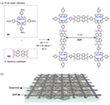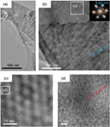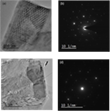2D Polyimide-Graphene Heterostructures
April 09, 2021 - Two-dimensional polymers (2DPs) are a class of atomically/molecularly thin crystalline organic 2D materials. They are intriguing candidates for the development of organic–inorganic 2D van der Waals heterostructures (vdWHs). In this work, we demonstrate the on-water surface synthesis of large-area (cm2), monolayer 2D polyimide (2DPI) with 3.1-nm lattice. Such 2DPI comprises metal-free porphyrin and perylene units linked by imide bonds. We achieve a scalable synthesis of 2DPI-graphene (2DPI-G) vdWHs via a face-to-face co-assembly of graphene and 2DPI on the water surface. Using femtosecond transient absorption spectroscopy we found an ultra-fast interlayer charge transfer (ca. 60 fs) in the resultant 2DPI-G vdWH upon protonation by acid, which is equivalent to that of the fastest reports among inorganic 2D vdWHs. Such large interlayer electronic coupling is ascribed to the interlayer cation–π interaction between 2DP and graphene.
In recent years, synthetic Two-dimensional (2D) van der Waals heterostructures (vdWHs) have attracted increasing attentions due to the miscellaneous components and novel functions in, e.g., electronic devices.[1] Through surface reconstruction and proximity effects between the neighboring layers, the opto-electrical properties of vdWHs can be tailored for tuning of carrier density, enhancement of electron-hole separation, and accelerated charge transfer.[2-5] Furthermore, numerous exotic physical phenomena have emerged owing to the strong interlayer interactions such as moiré pattern in graphene/hexagonal boron nitride (G/h-BN).[6] Despite versatile studies, 2D vdWHs reported so far are limited to inorganic 2D materials. It has remained largely unexplored to develop organic components for constructing organic–inorganic hybrid 2D vdWHs.
2D polymers (2DPs) have recently emerged as a new generation of atomically/molecularly thin organic 2D materials, which comprise repeated units linked via covalent bonds with long-range order in two distinct directions.[7-9] Recent advances of on-water surface synthesis strategies have paved the way to achieving single- to few-layer crystalline 2DPs.[7,10,11] Owing to the homogenous, free-standing, transferable and large-area (up to cm2) characteristics,[8], the resultant 2DPs are attractive for the construction of 2D vdWHs.[11] Moreover, compared with inorganic 2D materials, 2DPs can be readily tailored to a much higher degree by using abundant building blocks and linkage chemistries. Thereby, 2DP-based vdWHs are highly attractive owing to their tunable physicochemical properties and designable functions. Nevertheless, 2DP-based vdWHs have remained rarely explored so far because of the challenge to synthesize structurally defined 2DP monolayers.
In this work, we demonstrated the preparation of 2D polyimide (2DPI)-graphene (G) vdWH by the on-water surface synthesis and assembly strategy. The 2DPI was firstly synthesized by polycondensation between 5,10,15,20-tetrakis(4-aminophenyl)porphyrin (M1) and perylene-3,4,9,10-tetracarboxylic dianhydride (M2), as shown in Figure 1. The achieved 2DPI is a large-area (tens of cm2), free-standing film with a sub-nanometer thickness (0.8 nm). Subsequently, 2DPI-G was built up by the assembly of 2DPI with electrochemically exfoliated graphene on the water surface and followed up by transferring to substrates with additional annealing. The unique structure of 2DPI-G was proved by grazing incidence wide-angle X-ray scattering (GIWAXS), which presented a 3.14-nm lattice for the 2DPI crystal and a 0.23-nm lattice for graphene, thus demonstrating the co-existence of both 2D materials in the vdWHs. Aberration-corrected high-resolution transmission electron microscopy (AC-HRTEM) revealed hexagonal moiré fringes, indicating the face-to-face stacking between graphene and 2DPI. Remarkably, after the protonation of the porphyrin units in 2DPI (H-2PI) by hydrochloric acid, the femtosecond transient absorption spectroscopy (fs-TA) revealed that the H-2DPI-G displayed a strong acceleration of the relaxation dynamics related to an interfacial charge transfer from H-2DPI to graphene. The interlayer charge transfer time of about 60 fs achieved in the H-2DPI-G heterostructure is comparable to that of the fastest reports among inorganic vdWHs, such as graphene-WS2 (83 fs).[12]
The procedure from Step 1 to Step 4 deals with the synthesis of 2DPI. In Step 1, a chloroform solution of M1 (0.1 mL, 1 mg mL−1) was spread onto the water surface. After 5 min evaporation of chloroform, the Delrin barriers were driven forward to compress M1 on the water surface at a rate of 1 mm min−1 (Step 2). When the surface pressure reached 10 mN m−1, M1 could be assembled as a monolayer with a mean molecular area (MMA) of 6 Å2, according to its surface pressure (SP)–mean molecular area (MMA) isotherm (Supporting Information, Figure S1). Then, M2 (20 mL, 1 mg mL−1, dissolved in 1 mg mL−1 LiOH aqueous solution, ca. 200 molar equivalents to M1) was gradually injected into the trough (Step 3). And the subphase was tuned to be alkaline (pH 11). M2 then slowly diffused to the air–water interface and got adsorbed onto the M1 monolayer and induced the 2D polymerization. After 30 h of reaction, we achieved a ca. 20 cm×7.5 cm thin film floating on the water surface (Step 4, Figure 2).
Afterwards, the film was transferred onto a solid substrate and further annealed at 100 °C for 1 hour to complete the reaction of residual functional monomers and remove the water. Following the synthesis of the 2DPI, Step 5 and Step 6 are concerned with the fabrication of the 2DPI-G vdWHs. In Step 5, an aqueous suspension of high-quality electrochemically exfoliated graphene16 (EG has an average lateral size of ca. 2 μm and 80 % mono- to tri-layer graphene; ca. 1 mg mL−1, 2 mL) was injected into the aqueous subphase. Graphene flakes then could attach to the bottom surface of the 2DP monolayer driven by the π-π stacking interaction. To prepare the 2DPI-G, we repeatedly transferred films to other substrates (Step 6). As shown in Figure 3 a, the achieved vdWHs exhibited layered morphology via the repeated transfer method. The EG flakes are distributed in the 2DPI-G without significant aggregation as can be seen in Figure 3 b. We then explored the crystal structure of 2DPI-G. The chemical instability of ultrathin organic materials can always result in the collapse of their internal ordered structure and even decomposition at ambient condition, especially under electron radiation.11c To solve this problem, grazing incidence wide-angle X-ray scattering (GIWAXS) was utilized to characterize the pristine crystal structures of 2DPI-G.
The 2DPI-G heterostructures are visualized with aberration-corrected high-resolution transmission electron microscopy (AC-HRTEM). As shown in Figure 4 a, one can observe moiré patterns in the 2DPI-G. Figure 4 b presents a highly ordered in-plane structure in the selected area as marked in Figure 4 a. Its FFT pattern reveals that the superlattice structure has hexagonal moiré fringes with periodicity of ca. 9.39 and ca. 5.62 nm, demonstrating the face-on orientation of 2DPI-G. However, unlike GIWAXS investigation, we did not observe the 3.0 nm periodicity in the TEM image, which is mostly due to the extreme sensitivity of 2DPI monolayer toward electron irradiation damage. Figure 4 c shows a zoom-in image of the selected part of Figure 4 b, which manifests the superlattice structures. The graphene lattice with d space of 0.24 nm was presented with higher magnification at the atomic resolution (showing 0.22 nm in Figure 4 d). It should be noted that different superlattices can be observed, which are attributed to the random rotation of EG during the co-assembly with 2DPI (Figure S3).
All the SAED patterns in Figure 5 shows the diffraction patterns of graphene, corresponding to 0.21 nm, which are consistent with Figure 4.
The relaxation dynamics of charge carriers in 2DPI-G was characterized by the TA spectroscopy. However, we only obtained the signal of graphene in 2DPI-G samples (Figure 6a,b), because relaxation in graphene dominates the decay process which diminishes the signal of 2DPI. This result also indicates that the interlayer charge transfer is not significant due to the weak electronic interaction between pristine 2DPI and graphene. To overcome this obstacle, we protonated 2DPI-G with HCl (37 %wt), which is denoted as H-2DPI-G. Compared with 2DPI-G and 2DPI, the S band of H-2DPI-G significantly broadened (Figure 6c) due to a shoulder peak formation, which could be further divided into a narrow absorption peak at 438 nm and a broad absorption peak at 481 nm. The Q bands (400 nm to 600 nm) were red-shifted and merged into a single broad band peaked at 709 nm. The significant red shift of absorption band is related to the cation-π interaction between graphene and porphyrin structures in the vdWH, which can enhance the interlayer interaction in H-2DPI-G.[13]
Figure 6 d presents a noticeable acceleration of the relaxation dynamics of H-2DPI-G with near-resonant excitation at 470 nm. Both fast and slow decay processes of H-2DPI-G are influenced by the charge transfer from H-2DPI to graphene. The most remarkable effect is the emergence of the pronounced fast relaxation process caused by the proximity of the graphene layer. By comparing the UV/Vis absorption around 470 nm (see Figure 6 c), the fast decay in H-2DPI-G is attributed to the relaxation of the lower energy level. Fitting with a bi-exponential decay function gives the relaxation time constants of the fast and slow decays in H-2DPI-G that are equal to 61.5±6.5 fs and 1700±100 fs, respectively. The timescale of ca. 60 fs of the dominating relaxation defines the speed of the interlayer charge transfer in H-2DPI-G. Similar timescales have been reported for ultra-fast charge transfer in inorganic vdWHs, i.e., transition-metal dichalcogenide/graphene heterostructures. [12]
In summary, we demonstrated the novel on-water surface synthesis of 2DPI and its assembly with graphene for the construction of unprecedented 2DPI-based vdWHs. Guided by the strong interlayer cation-π interaction between protonated H-2DPI and graphene, the resultant H-2DPI-G exhibited remarkable ultra-fast charge transfer within 60 fs. The on-water surface synthesis approach holds promise as a general method for the preparation of organic-inorganic vdWHs. The structures of 2DPs can be further adjusted for engineering their band gaps and enhancing the charge transfer. A critical aspect of the future work will be the study of organic-inorganic interlayer coupling that can lead to unique quantum phenomena.
Resource: Kejun Liu, Jiang Li, Haoyuan Qi, Mike Hambsch, Jonathan Rawle, Adrián Romaní Vázquez, Ali Shaygan Nia, Alexej Pashkin, Harald Schneider, Mirosllav Polozij, Thomas Heine, Manfred Helm, Stefan C. B. Mannsfeld, Ute Kaiser, Renhao Dong, Xinliang Feng. A Two-Dimensional Polyimide-Graphene Heterostructure with Ultra-fast Interlayer Charge Transfer (2021) Angewandte Chemie 133, 13978-13983, doi: 10.1002/ange.202102984, [PDF], see also the supporting information.
-
T. Georgiou, R. Jalil, B. D. Belle, L. Britnell, R. V. Gorbachev, S. V. Morozov, Y.-J. Kim, A. Gholinia, S. J. Haigh, O. Makarovsky, L. Eaves, L. A. Ponomarenko, A. K. Geim, K. S. Novoselov, A. Mishchenko, Vertical field-effect transistor based on graphene–WS2 heterostructures for flexible and transparent electronics. Nat. Nanotechnol. 2013, 8, 100– 103.
-
B. Dereka, A. Rosspeintner, M. Krzeszewski, D. T. Gryko, E. Vauthey, Symmetry‐breaking charge transfer and hydrogen bonding: Toward asymmetrical photochemistry. Angew. Chem. Int. Ed. 2016, 55, 15624– 15628;
-
A. C. Jakowetz, M. L. Böhm, J. Zhang, A. Sadhanala, S. Huettner, A. A. Bakulin, A. Rao, R. H. Friend, What controls the rate of ultrafast charge transfer and charge separation efficiency in organic photovoltaic blends. J. Am. Chem. Soc. 2016, 138, 11672–11679;
-
C. E. Petoukhoff, M. B. M. Krishna, D. Voiry, I. Bozkurt, S. Deckoff-Jones, M. Chhowalla, D. M. O'Carroll, K. M. Dani, Ultrafast charge transfer and enhanced absorption in MoS2–organic van der Waals heterojunctions using plasmonic metasurfaces. ACS Nano 2016, 10, 9899– 9908;
-
H. Tan, W. Xu, Y. Sheng, C. S. Lau, Y. Fan, Q. Chen, M. Tweedie, X. Wang, Y. Zhou, J. H. Warner, Lateral graphene‐contacted vertically stacked WS2/MoS2 hybrid photodetectors with large gain. Adv. Mater. 2017, 29, 1702917.
-
M. Yankowitz, J. Xue, D. Cormode, J. D. Sanchez-Yamagishi, K. Watanabe, T. Taniguchi, P. Jarillo-Herrero, P. Jacquod, B. J. Leroy, Emergence of superlattice Dirac points in graphene on hexagonal boron nitride. Nat. Phys. 2012, 8, 382– 386.
-
H. Sahabudeen, R. Dong, X. Feng, Interfacial synthesis of structurally defined organic two-dimensional materials: progress and perspectives. Chimia 2019, 73, 480– 486;
-
R. Dong, T. Zhang, X. Feng, Interface-assisted synthesis of 2D materials: trend and challenges. Chem. Rev. 2018, 118, 6189– 6235;
-
J. Sakamoto, J. van Heijst, O. Lukin, A. D. Schluter, Two‐dimensional polymers: just a dream of synthetic chemists? Angew. Chem. Int. Ed. 2009, 48, 1030– 1069;
-
K. Liu, L. Wang, R. Dong, Two-dimensional conjugated polymer films via liquid-interface-assisted synthesis toward organic electronic devices. J. Mater. Chem. C 2020, 8, 10696– 10718;
-
P. Kissel, R. Erni, W. B. Schweizer, M. D. Rossell, B. T. King, T. Bauer, S. Gotzinger, A. D. Schluter, J. Sakamoto, A two-dimensional polymer prepared by organic synthesis. Nat. Chem. 2012, 4, 287– 291;
-
Z. Song, H. Zhu, W. Shi, D. Sun, S. Ruan, Ultrafast charge transfer in graphene-WS2 Van der Waals heterostructures. Optik 2018, 174, 62– 67.
-
Y. Xu, L. Zhao, H. Bai, W. Hong, C. Li, G. Shi, Chemically converted graphene induced molecular flattening of 5,10,15,20-Tetrakis(1-methyl-4-pyridinio)porphyrin and its application for optical detection of Cadmium(II) ions. J. Am. Chem. Soc. 2009, 131, 13490– 13497.






